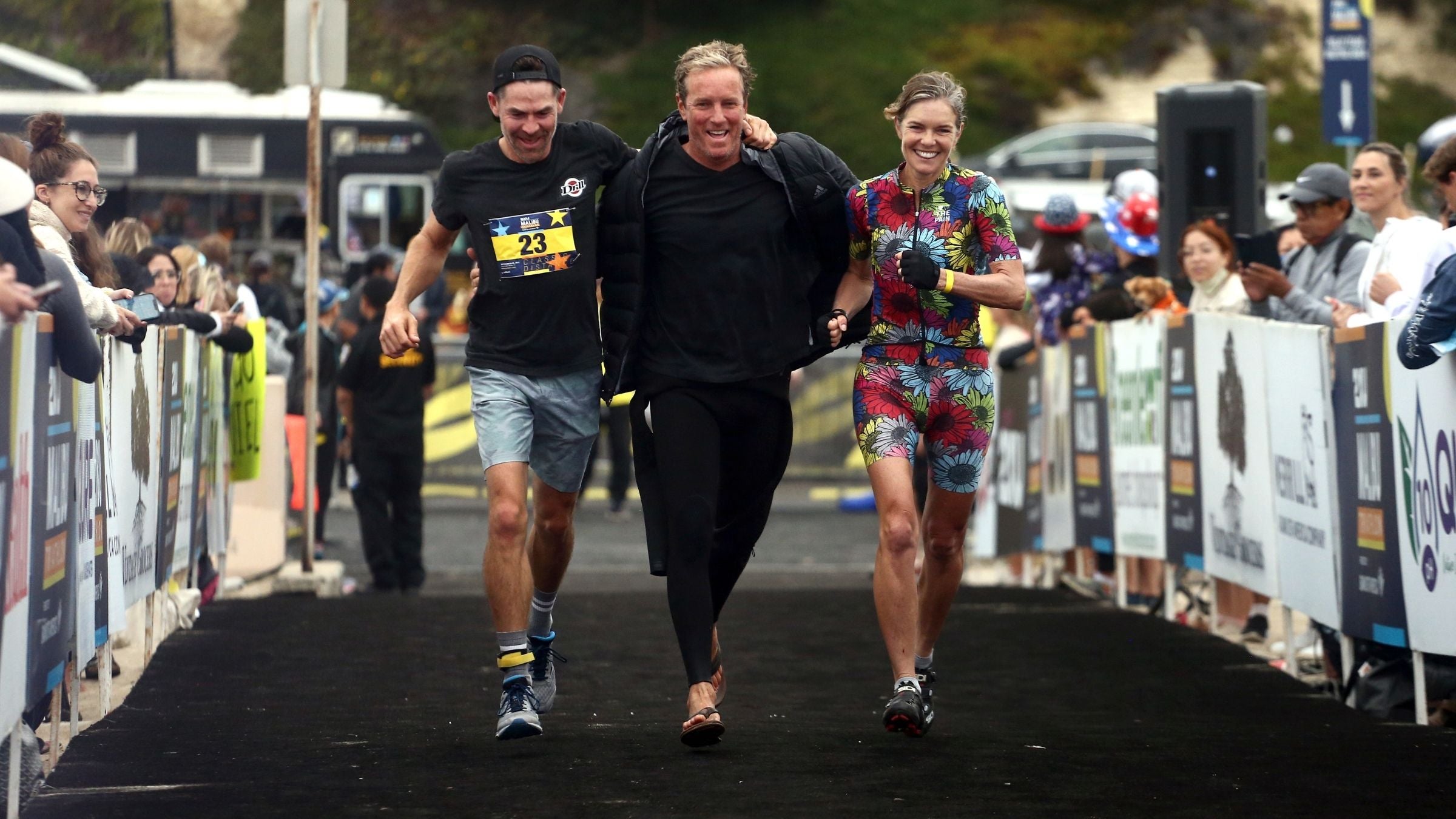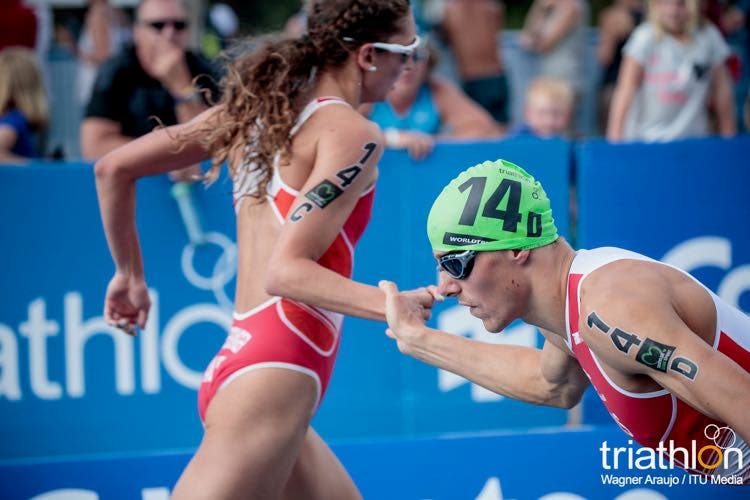How To Do A Triathlon Relay

(Photo: Tommaso Boddi/Getty Images)
For the most part, triathlon is a solo sport. Although we rely on a large network of supporters, a coach, family members, and training partners who help us get to the start line, the competition is often a solitary endeavor. However, in some instances, triathlon can be a team sport, like with a triathlon relay.
There are two types of triathlon relays:
- The traditional relay, where each person does one leg of the triathlon
- A mixed relay (where every person does a mini-triathlon in full
Both relay options are great ways to jump into the sport of triathlon if you haven’t tried it yet, or for more experienced athletes to test themselves in a thrilling competitive format. Here’s how to do a triathlon relay.
What is a triathlon relay?
If you’re new to triathlon, dipping a toe in the water by participating on a relay team is a great way to get started. You can learn the ins and outs of competition, get used to navigating a transition area, and gain experience on the race course. It can also be less intimidating to participate in your first triathlon as part of a team, because you can select the discipline that plays to your strengths.
The set-up for a triathlon relay is fairly straightforward. A relay team consists of two to three people with each team member performing one or two legs of the event. For example, a team might consist of Sally, Bill, and Rick. Sally might do the swim; Bill would bike; and Rick would tackle the run. However, in the case that Sally is feeling ambitious, she might decide to do both the swim and run portions and let Bill do the bike. Another fun aspect of the triathlon relay is that teams can be co-ed and consist of athletes of different ages.
In order to keep track of a relay team’s overall time throughout the race, a timing chip, or bib in the case of a duathlon (run-bike-run), must be transferred from one teammate to the next upon completion of each leg of the race. At most races, there will be a designated area where team members will wait to pass off the timing chip before the athlete can move on to the next discipline. In some cases, this means only the athlete who is doing the bike leg is allowed in the transition area. The cyclist must collect the timing chip from the swimmer before running into transition and un-racking the bike; they then rack their bike after finishing their leg before passing the chip on to the runner. In the case that a relay pen isn’t provided, all team members typically meet at the bike rack.
Because the timing chip acts as a sort of “baton,” team members must hand off the chip in order to move on to the next leg of the race. The timing chip is transferred from one athlete to the next and should be worn on the left ankle at all times. A good tip is to plan ahead so you have a rough estimate of each athlete’s finish time, so you can be prepared for a quick hand-off.
Triathlon relay distances
There are all kinds of triathlon relays. Distances include super sprint, sprint, Olympic, and the 70.3 distance. The relay option isn’t typically offered in full Iron-distance races, though there are some unique events. Specific distances may vary slightly, but most stick to the standard swim, bike, and run distances of a triathlon.
| Super Sprint | 400m | 10km | 2.5km |
| Sprint | 750km | 20km | 5km |
| Olympic distance | 1.5km | 40km | 10km |
| Half-Iron (or 70.3) | 1.2mi | 56mi | 13.1mi |
Half-Iron or 70.3 relays
With the growth of the popularity of the half-iron distance, triathlon relays at that distance have become increasingly popular in recent years, because it gives each team member a taste of competing in a long-course event without having to tackle the entire race on their own.
It’s important to keep in mind that Ironman brand races do have time cut-offs for each discipline, and they are enforced for relay teams in addition to the individual athletes.
“We want all relay members to have the opportunity to race,” said Keats McGonigal, vice president of operations for The Ironman Group. “There are times when we can enable this to happen if previous members do not complete their leg of the race in the allotted time. For safety reasons, there are other times when some relay members may not continue. The decision on this is made race by race. If any member of the relay does not complete the event in the allotted time, the entire relay team will show as a DNF in the results.”
One commonly asked question is if all team members are able to cross the finish line together. For Ironman relays, only the runner is permitted to cross the finish line, but each team member will receive a finisher’s medal and the entire team is allowed to take an official photo in the finisher’s chute. At some smaller or non-Ironman brand events, the race directors will allow the whole relay team to run through the finish chute together. Check with the race director or race FAQs before your relay.
Triathlon relays: Not just for beginners
“It’s a lot of fun to give everything you’ve got in one leg of the race and then be done racing for the day,” said David Wilson, 49, whose relay team won the relay division at Florida 70.3 in December. Wilson races triathlon throughout the year, so doing a late-season relay was “a bit of a break” and an opportunity to practice one discipline all-out. Relays also give experienced athletes a chance to get out on the race course before their key race, work on some specific skills, or get in a race in one discipline if they’re injured and can’t do all three.
Wilson was the designated swimmer on his team, so it was important that he start his team off right with a quick transition. “When I came in from the swim leg, our bike athlete took the timing chip off my leg when I arrived at the bike rack and put it on his leg before removing his bike from the rack. When our bike athlete came into transition, he racked his bike. Then, our run athlete took the chip, put it on, and took off to run. It’s that simple!”
David has a few tips for anyone wanting to try a triathlon relay.
“Take the time to train properly for the swim, bike, or run, depending on what leg you plan to do and have your nutrition routine down before racing so you can crush it out on the course. All races and venues are different, and things don’t always go right. When something goes wrong, don’t get mad or frustrated, just embrace it and work through it to move on.”
“There will be plenty of spectators cheering you on which will motivate and inspire you,” he said, so come with the right attitude and enjoy the day.
Wait, what is the triathlon mixed team relay?

You might have seen mixed team relay make its debut at the Tokyo Olympics — and a growing number of age-group mixed relay options are giving regular triathletes a chance to try this unique format.
Unlike in a regular triathlon relay, where one person does each leg (swim, bike, or run), a mixed team relay has each athlete do an entire mini triathlon before “tagging” the next member of the relay team to begin. Each team is made up of two men and two women, alternating female/male/female/male. At the Olympics and on the World Triathlon circuit, each athlete completes a super sprint triathlon typically of a 300m swim, 6.8km bike, and 2km run. Drafting is allowed on the bike at that elite level and the racing is fast and intense.
USA Triathlon featured the first-ever age-group mixed relay national championships at its 2023 multisport festival in Texas, and the event has gained steam as a thrilling way to race. Pick some teammates (here’s how) and start practicing.
RELATED: What is Triathlon Mixed Team Relay?